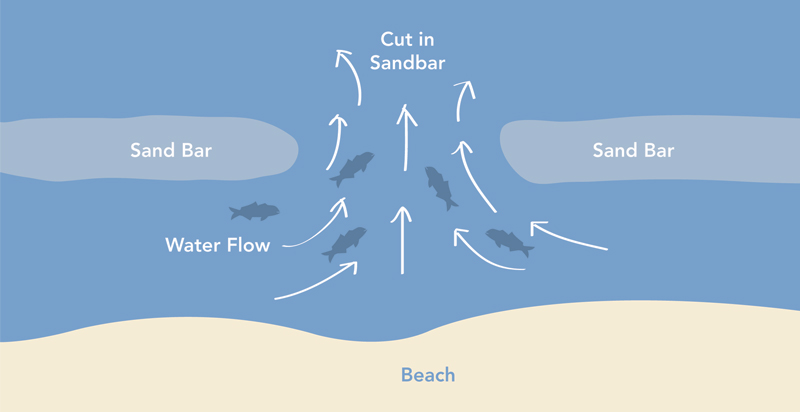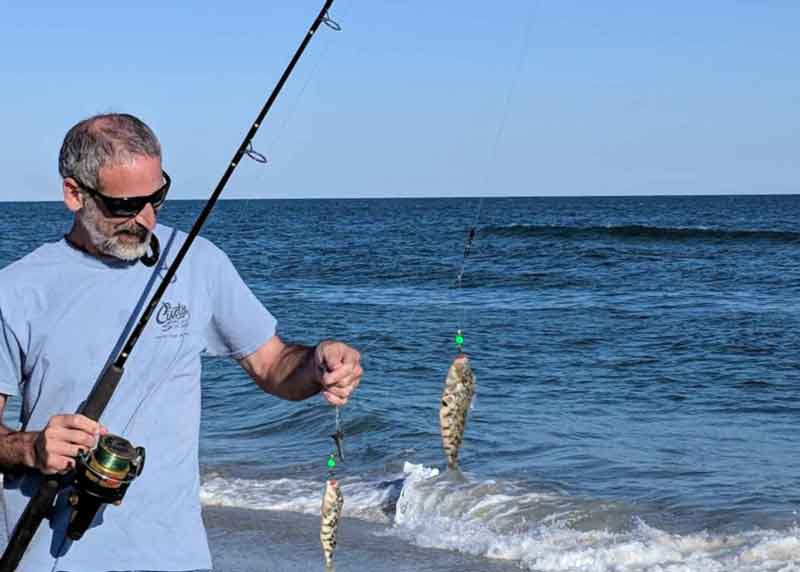Many of us vacation in places like Ocean City or Virginia Beach, and for the typical beach-goer, there is sun, sand, and water. Ocean waves are ideal for jumping, body surfing, and having fun at the beach. Where an umbrella is set up and a blanket is spread out makes little difference. For anglers hitting the beach, it’s not quite that simple. Sure, we can walk onto the beach just about anywhere, cast a line in the water, and maybe catch a fish or two. But the difference between a highly successful outing and a mere relaxing day on the beach comes down to where your lines are cast. Contrary to what many people may think, the beach is not all the same – at least not under the water.

Feeding at the Troughs
The gentle beach slope changes just after entering the surf. During low tide there’s a drop off within a few feet of the shoreline; this is the first trough. It’s located between the beach and the first sandbar. You can’t miss it when wading into the surf, it’s the drop off where shells often gather underfoot as you enter the ocean. During flood tide this trough may be 20 to 50 feet from the edge of the surf, depending on how far the tide comes up the beach. Especially at high tide, this first trough often holds an array of fish gobbling up sand fleas, crabs, and smaller prey – or your baited hook. This trough can be productive at low tide as well, depending on its depth. Many anglers believe they need to cast far out, when actually, often many fish are literally just feet off the beach.

The outer trough is another fish-gathering area. Both of these troughs tend to be most productive during incoming and turn of the tide. But depending on depth, one or the other can be productive throughout both tidal cycles.
Hitting the Bars
One of the best locations to fish is where there’s a cut through the bars, especially the outer bar. It can be thought of as a roadway where the fish travel to and from the troughs. These cuts are formed by wave movement. Ocean swells approaching the shore start to build in height when water depth is 1.5 times the swell’s height or less. Once water depth is about 1.3 times the wave height, the wave breaks. So as an ocean swell approaches the shallow outer sandbar, it builds into a wave and crashes. The water then continues moving towards shore and crosses over the outer trough. It is here, where the water becomes deeper again, that another smaller wave forms and then breaks on the inner sand bar or, depending on tide, water depth, and wave height, rolls right in to break on the shoreline. As the water rush back out, water pressure builds up between the bars and shoreline. That water has to go somewhere, and as it rushes back out it often washes sand out and eats open these cuts we’re looking for. Typically, this happens the most during storms or heavy surf.

Sometimes you can visually see the water rushing away from the shoreline and ID a cut. But often this water movement is subtle, especially in relatively calm conditions long after the cut has been formed. By watching the wave’s reactions over holes, depressions, and troughs, however, these deeper areas can often be located long after the seas have calmed back down. In this case, watching how the waves build up and react to the outer sandbar can expose where the cut is located. Watch the waves approaching a sandbar, and it will be observed that a wave builds and breaks along a length of the bar. However, you may notice that waves don’t break in one particular area. If wave after wave does not break at that same one spot, but breaks everywhere else along the outer bar, you’ve spotted the cut with deeper water. Which to surf anglers means: set up here!
During low tide the typical wave builds up and crashes onto the outer bar. During high tide, waves often build without breaking, and roll over the outer bar. So it’s always better to scout out prime fishing locations on a low tide, when the breaking waves make cuts easier to spot.
On calm days changes in water color can also be a give-away, with darker areas indicating more depth. Or a section of the wave may not build up as high in one area, again meaning increased depth of water from a trough, a cut, or large depression in the sand. If you enjoy swimming in the ocean, during low tide walk around between the beach and bars to identify these holes, depressions or troughs. Take note of these areas, which often will be holding fish during the end of the incoming and turn of flood tide.
Fish tend to feed closer to shore during early morning and evenings, when the sun is low on the horizon. Throw in a high tide during these times, and fishing improves. However, don’t give up on a low tide. As the water recedes down the beach, it gives you the best opportunity to cast over the outer bar without wading out far out into the surf. Just like troughs holds fish, the drop-off on the far side of the outer sandbar is another area where fish stage, waiting on the incoming tide to raise water depth before crossing the outer sandbar to feed near shore.

Sometimes it’s tough to cast far enough to reach this deep water, but when fishing on Assateague at low tide, I’m normally able to cast over the outer bar. Throw in a west breeze to my back and I’m clearing the bar by a good bit, placing a double bottom rig in fish-rich water. This typically results in decent catches, especially when kingfish are present feeding right behind the waves breaking onto the outer sandbar.
Of course, these bars, cuts, and troughs are constantly shifting and changing, and one week to the next or even one day to the next can present completely different surf structure. So on your next trip to the surf and on every trip, take a couple minutes to study the water before casting a line. It just may put a few extra fish in the cooler – and it might make the difference between a day of catching and a day of sunbathing at the beach.
-By John Unkart, author of “Offshore Pursuit” and “Saltwater Tales.”